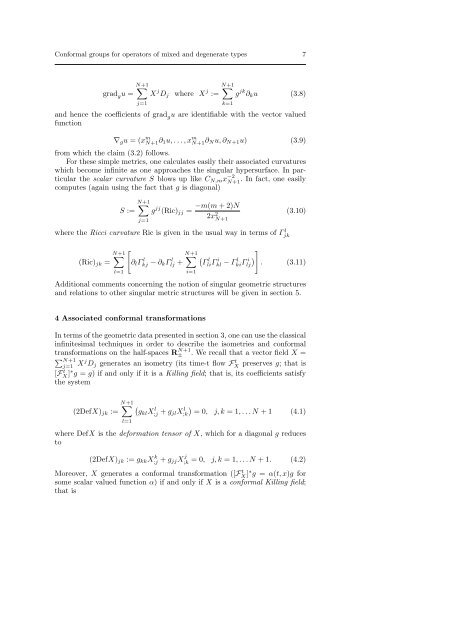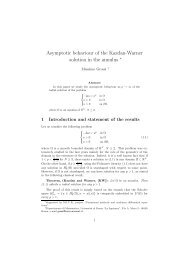Singular metrics and associated conformal groups underlying ...
Singular metrics and associated conformal groups underlying ...
Singular metrics and associated conformal groups underlying ...
You also want an ePaper? Increase the reach of your titles
YUMPU automatically turns print PDFs into web optimized ePapers that Google loves.
Conformal <strong>groups</strong> for operators of mixed <strong>and</strong> degenerate types 7<br />
grad gu =<br />
N+1 <br />
j=1<br />
X j Dj where X j :=<br />
N+1 <br />
k=1<br />
g jk ∂ku (3.8)<br />
<strong>and</strong> hence the coefficients of grad gu are identifiable with the vector valued<br />
function<br />
∇gu = (x m N+1∂1u, . . . , x m N+1∂Nu, ∂N+1u) (3.9)<br />
from which the claim (3.2) follows.<br />
For these simple <strong>metrics</strong>, one calculates easily their <strong>associated</strong> curvatures<br />
which become infinite as one approaches the singular hypersurface. In particular<br />
the scalar curvature S blows up like CN,mx −2<br />
N+1 . In fact, one easily<br />
computes (again using the fact that g is diagonal)<br />
S :=<br />
N+1 <br />
j=1<br />
g jj (Ric)jj =<br />
−m(m + 2)N<br />
2x 2 N+1<br />
where the Ricci curvature Ric is given in the usual way in terms of Γ l jk<br />
(Ric)jk =<br />
N+1 <br />
l=1<br />
<br />
∂lΓ l kj − ∂kΓ l<br />
lj +<br />
N+1 <br />
i=1<br />
(3.10)<br />
l<br />
ΓliΓ i kl − Γ l kiΓ i <br />
lj<br />
<br />
. (3.11)<br />
Additional comments concerning the notion of singular geometric structures<br />
<strong>and</strong> relations to other singular metric structures will be given in section 5.<br />
4 Associated <strong>conformal</strong> transformations<br />
In terms of the geometric data presented in section 3, one can use the classical<br />
infinitesimal techniques in order to describe the isometries <strong>and</strong> <strong>conformal</strong><br />
transformations on the half-spaces R N+1<br />
± . We recall that a vector field X =<br />
N+1 j=1 Xj Dj generates an isometry (its time-t flow F t X preserves g; that is<br />
[F t X ]∗g = g) if <strong>and</strong> only if it is a Killing field; that is, its coefficients satisfy<br />
the system<br />
(2DefX)jk :=<br />
N+1 <br />
l=1<br />
<br />
gklX l ;j + gjlX l <br />
;k = 0, j, k = 1, . . . N + 1 (4.1)<br />
where DefX is the deformation tensor of X, which for a diagonal g reduces<br />
to<br />
(2DefX)jk := gkkX k ;j + gjjX j<br />
;k = 0, j, k = 1, . . . N + 1. (4.2)<br />
Moreover, X generates a <strong>conformal</strong> transformation ([F t X ]∗ g = α(t, x)g for<br />
some scalar valued function α) if <strong>and</strong> only if X is a <strong>conformal</strong> Killing field;<br />
that is








